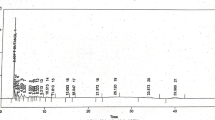Abstract
We develop a method on the basis of high-performance liquid phase chromatography–mass spectrometry (HPLC-MS) for determination of triterpene glycosides in ginseng extracts. In contrast to procedures based on HPLC with ultraviolet detection (HPLC-UV), commonly used for extract standardization, superior selectivity afforded by the developed method enables identification and quantitation of 23 major and minor ginsenosides. For this, in addition to using MS for highly selective detection of adduct ions composed of ginsenoside molecules and sodium and fragment sapogenin ions, we identify the conditions for chromatographic separation on a sorbent with grafted pentafluorophenyl groups. The effects that the temperature and mobile phase composition have on the selectivity of glycoside determination receive special attention here. For some pairs of compounds (F4/Rg6 and Rk3/Rh4), complete separation of chromatographic peaks is not achieved; nevertheless, even if present simultaneously, they can be determined owing to their different m/z ratios. The linearity ranges, equations for calibration curves, and analytical parameters (i.e., the limit of detection and reproducibility) are established for all analytes. The developed method is tested for standardization of reference extracts of Asian (P. ginseng) and American (P. quinquefolius) ginseng roots. For some ginsenosides, the content claimed by the manufacturer is at variance with the actual values, while for others the determined concentrations proved to be close to the claimed values. Additionally, we succeed in expanding the range of determinable ginsenosides, which is important for medical application of such extracts.





Similar content being viewed by others
REFERENCES
Dharmananda, S., The nature of ginseng: traditional use, modern research and the question of dosage, HerbalGram, 2002, vol. 54, pp. 34–51.
ESCOP Monographs, Exeter: Eur. Sci. Coop. Phytother., 2003, 2nd ed.
Kiefer, D. and Pantuso, T., Panax ginseng, Am. Fam. Phys., 2003, vol. 68, no. 8, pp. 1539–1542.
Yang, W.Z., Ye, M., Qiao, X., et al., A strategy for efficient discovery of new natural compounds by integrating orthogonal column chromatography and liquid chromatography/mass spectrometry analysis: Its application in Panax ginseng, Panax quinquefolium and Panax notoginseng to characterize 437 potential new ginsenosides, Anal. Chim. Acta, 2012, vol. 739, pp. 56–66.
Mathon, C., Duret, M., Kohler, M., et al., Multi-targeted screening of botanicals in food supplements by liquid chromatography with tandem mass spectrometry, Food Chem., 2013, vol. 138, no. 1, pp. 709–717.
Stavrianidi, A.N., Rodin, I.A., Braun, A.V., et al., Simultaneous determination of ginsenosides by high-performance liquid chromatography with tandem mass spectrometry detection, J. Anal. Chem., 2014, vol. 69, no. 13, pp. 1252–1258.
Li, W.K., Gu, C.G., Zhang, H.J., et al., Use of high performance liquid chromatography-tandem mass spectrometry to distinguish Panax ginseng C. A. Meyer (Asian ginseng) and Panax quinquefolius L. (North American ginseng), Anal. Chem., 2000, vol. 72, no. 21, pp. 5417–5422.
Wan, J.B., Li, S.P., Chen, J.M., and Wang, Y.T., Chemical characteristics of three medicinal plants of the Panax genus determined by HPLC-ELSD, J. Sep. Sci., 2007, vol. 30, no. 6, pp. 825–832.
Chan, T.W., But, P.P., Cheng, S.W., et al., Differentiation and authentication of Panax ginseng, Panax quinquefolius and ginseng products by the use of HPLC/MS, Anal. Chem., 2000, vol. 72, no. 6, pp. 1281–1287.
The United States Pharmacopeia, Rockville, MD: US Pharmacopeial Convention, 2007, 30th ed.
Lau, A.J., Seo, B.H., Woo, S.O., and Koh, H.L., High-performance liquid chromatographic method with quantitative comparisons of whole chromatograms of raw and steamed Panax notoginseng, J. Chromatogr. A, 2004, vol. 1057, nos. 1–2, pp. 141–149.
Li, L., Zhang, J.L., Sheng, Y.X., et al., Simultaneous quantification of six major active saponins of Panax notoginseng by high-performance liquid chromatography-UV method, J. Pharm. Biomed. Anal., 2005, vol. 38, no. 1, pp. 45–51.
Kim, S.N., Ha, Y.W., Shin, H., et al., Simultaneous quantification of 14 ginsenosides in Panax ginseng C.A. Meyer (Korean red ginseng) by HPLC-ELSD and its application to quality control, J. Pharm. Biomed. Anal., 2007, vol. 45, no. 1, pp. 164–170.
Sun, B.S., Gu, L.J., Fang, Z.M., et al., Simultaneous quantification of 19 ginsenosides in black ginseng developed from Panax ginseng by HPLC–ELSD, J. Pharm. Biomed. Anal., 2009, vol. 50, no. 1, pp. 15–22.
Cui, M., Song, F., Zhou, Y., et al., Rapid identification of saponins in plant extracts by electrospray ionization multi-stage tandem mass spectrometry and liquid chromatography/tandem mass spectrometry, Rapid Commun. Mass Spectrom., 2000, vol. 14, no. 14, pp. 1280–1286.
ACKNOWLEDGMENTS
This work was performed using the equipment acquired with funds from the Moscow State University Development Program.
Funding
The work was supported by the Russian Foundation for Basic Research (project no. mol_a_dk 16-33-60007).
Author information
Authors and Affiliations
Corresponding author
Ethics declarations
The authors declare that they have no conflicts of interest.
Additional information
Translated by A. Kukharuk
Rights and permissions
About this article
Cite this article
Fedorova, E.S., Stekol’shchikova, E.A., Shpigun, O.A. et al. Standardization of P. ginseng and P. quinquefolius Root Extracts by HPLC-MS. Inorg Mater 56, 1353–1361 (2020). https://doi.org/10.1134/S002016852014006X
Received:
Revised:
Accepted:
Published:
Issue Date:
DOI: https://doi.org/10.1134/S002016852014006X




